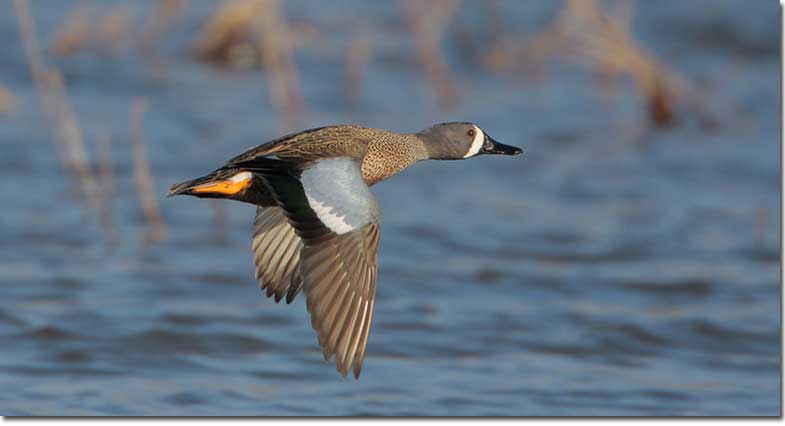The Blue-winged Teal (Anas discors) is a modest waterbird with blue spots on the wings.
This dabbling duck is a quick and agile flier, known for its rapid wing beats and darting movements, making for a challenging bird for hunters. Blue-winged Teal is a fierce survivor and an important part of many ecosystems.
Observing this lively bird in its natural habitat is a delight for both bird watchers and nature enthusiasts.
On this page
What Does a Blue-winged Teal Look Like?
Blue-winged Teal can grow up to 16 inches long and have a wingspan of 23 inches, making it one of the smallest ducks.
Adult male Blue-winged Teals have a light brown body covered in black spots. They have a dark bluish-gray head with a white crescent running vertically between their eyes and their black bill. Their wings and rear are also black, excluding the white patch near the rear.
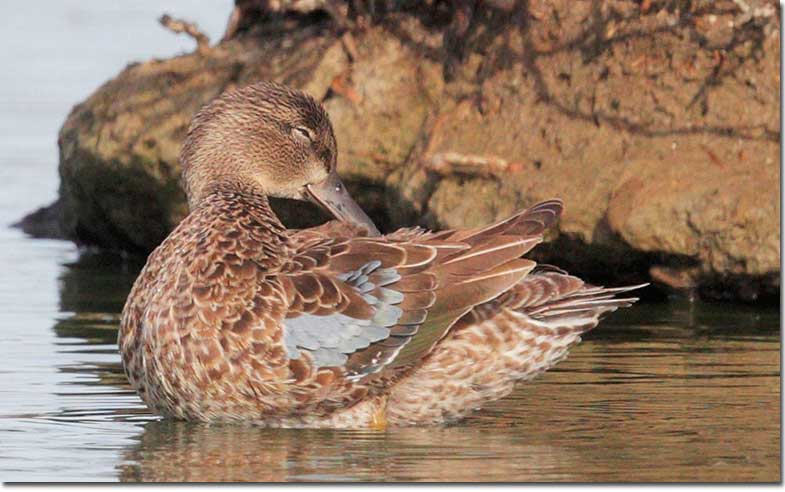
Female Blue-winged Teal
Adult female Blue-winged Teals are very modest and can blend well into their surroundings. They have a lighter brown plumage that is covered with dark brown “scales”. They have a darker brown cap on their head and a thin horizontal line running across their face and eyes.
Females don’t have the white patch on their rear nor the white crescent on their faces. Non-breeding and immature males look very similar to females.
Both sexes have light blue wing coverts, a green speculum, and light orange legs. You can often see them in flocks, also with other duck species.
Where Are Blue-winged Teals Found?
Blue-winged Teals range across all of North America, except for most of Alaska, the northern Yukon Territory, the northeastern area of Canada, and the northern Northwest Territories. They are rare on the west coast and in deserts.
They’re migratory birds. During the summer, which is also their breeding season, they can be found from southeastern Alaska to the Atlantic coast, from Great Plains to Louisiana, and the Gulf Coast of Texas. In the winter, they migrate southwards as far as Mexico and northern South America.
Where Does Blue-winged Teal Live?
Blue-winged Teal’s habitat is most of the time near water. They prefer shorelines or calm water to open water or fast water.
Inland, they can be found in marshes, ponds, lakes, and shallow streams that have a lot of emergent vegetation. In coastal areas, they can be found in salt marsh meadows that have adjoining creeks or ponds.
During the summer, they go through their flightless molt and live in ponds in open country, large but shallow freshwater marshes, or also brackish marshes near the coast. During migration and in the winter, they inhabit any kind of shallow waters.
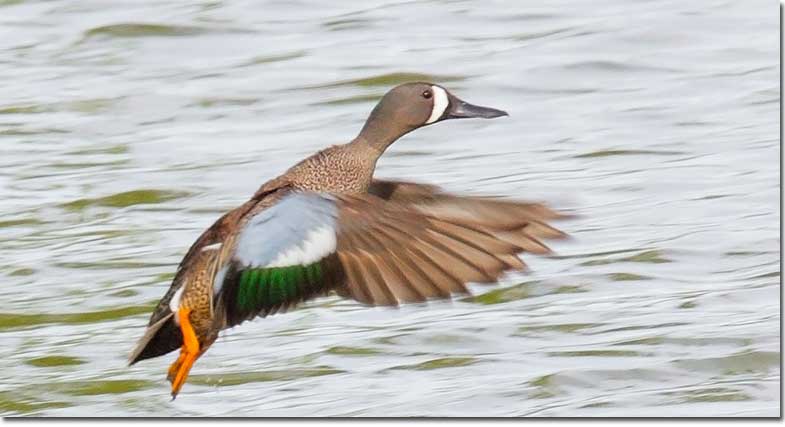
Blue-winged Teal on take off
What Do Their Nests Look Like?
Blue-winged Teals are seasonally monogamous, although the males don’t take part in nest building nor take care of the young.
These birds nest in northern prairie potholes, parklands, and wetland areas within grasslands, such as marshes, sloughs, and ponds. After choosing the nest site, the mother bird digs a bowl-shaped scrape and bolsters it with soft vegetation found around the nest and her own down and breast feathers. The nest site is typically near, but at least a foot away from the nearest water and covered by vegetation.
The female then lays 6-14 creamy white eggs, one per day. The eggs are 1.5-2 inches long and 1.1-1.5 inches wide. Eggs take 19-29 days to incubate, which the female does all alone. After hatching, the female cleans the ducklings and leads them to a nearby wetland. They stay with their mother until they are ready to fly, which is about 40 days after hatching.
What Do Blue-winged Teal Eat?
Blue-winged Teals are omnivores, eating small insects and aquatic creatures but also different plant matter.
You can see them foraging in shallow water, eating stuff from the surface, swimming forward with heads underwater, and rarely turning upside down so only their rear is sticking out. Sometimes you can also see them foraging away from water.
Their primary diet mainly consists of plant material, such as seeds, grasses, sedges, weeds, algae, etc. During the breeding season, the females need more protein and add insects, mollusks, marine invertebrates, larvae, snails, and other such small creatures into their diet.
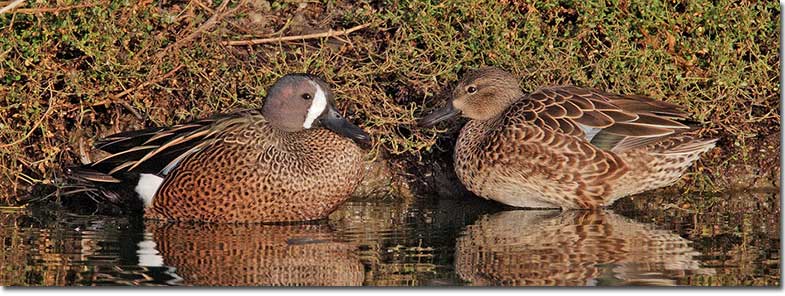
Pair of Blue-winged Teals
What Does A Blue-winged Teal Sound Like?
Blue-winged Teals’ call is different for males and females. The males give loud and high-pitched whistles that sound like peeew or a low-pitched nasal paay. It starts with one long call that is followed by more, increasingly faster calls. Paired males rarely call, so you can hear this mostly during fall and early winter.
Female Blue-winged Teals call during the mating season but also to communicate with their young. They give a series of evenly spaced single quacks.
When being pursued by another male, she warns them off with a specific gaek sound.
Facts
- Ducklings often don’t reach maturity due to diseases and parasites. Migration is another dangerous endeavor that can end in their death. However, the Blue-winged Teal that reaches adulthood can live up to 17 years old, with the known oldest bird reaching 23 years of age.
- Blue-winged Teals are thought to be one of the fastest ducks; however, they are actually one of the slowest with an average of 30 mph flight speed. The perception of their high speed comes from their rapid wingbeats, diving and maneuvering abilities, and that they usually don’t fly in a straight line. They can change direction on a dime and can attain great speeds while diving, which makes it hard to hit them.
- They’re long-distance migrants. One was seen in Alberta and then in Venezuela a month later. Some also migrate over the ocean.
Similar Species
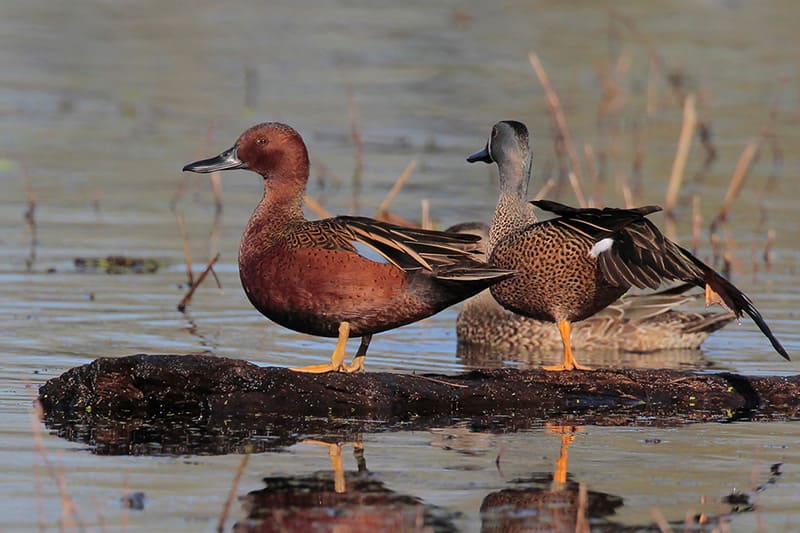
Cinnamon and Blue-winged Teal
Blue-winged Teals and Cinnamon Teals look similar in several ways. Cinnamon Teals have mainly reddish-orange plumage, but similarly to Blue-winged Teals, they have some blue and green feathers on their wings.
Blue-winged Teals have dark heads and a white stripe running across their face.
Both species are roughly the same size, and females look similar.
These two species can hybridize as well.
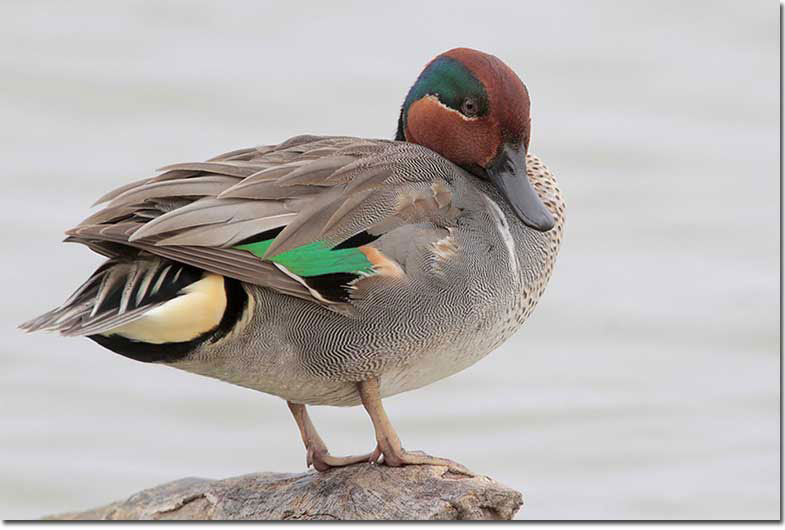
Green-winged Teal male
Compared to Blue-winged Teals, Green Winged Teals are grayer in color, plus, they have some green on their heads and necks too.
The wings of these two birds look different too. Green-winged Teals lack the blue parts on their wings, and the overall pattern on the wings looks different.
Green-winged Teals and Blue Winged Teals are around the same size, Green-winged Teals can be a bit smaller.
Females look similar, but female Green-winged Teals are darker in color.
Frequently Asked Questions
Why is it called a Blue-winged Teal?
Blue-winged Teal got its name from the sky-blue patches on its forewings.
How fast does a Blue-winged Teal fly?
Blue-winged Teals typically fly at around 30 mph, although they can reach greater speed while diving.

